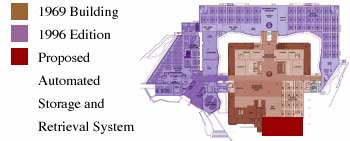“Computer, what was the population of Iceland in
1930?”
The disembodied “Star Trek” voice that responds
is what people have in mind when they think about the library
of the future. But libraries always have been and always will
be more than just repositories of facts. True, the library
is a source of information, from the first donation to the
University—books contributed by Henry Gassett and Brigham
Young—to today’s millions of volumes and tens
of thousands of online resources (including one that did,
in fact, find Iceland’s 1930 population: 108,629). More
than that, though, it is a place where students meet to work
on class projects, where faculty collaborate on research,
and where new users take classes to learn how to identify
and use the vast resources.
“Meet you at the library after class.”
“I’ll be studying at the library tonight.”
More than a disembodied voice. A place to meet, a place to
learn.
And that’s the goal of the latest library renovation
project, set to start in summer 2004: bringing the Marriott
Library into the 21st century while enhancing its timeless
function as the campus’ central meeting place.
Easier said than done, when the library is actually two libraries,
a 1960sera building surrounded by a 1990s addition. The inner
structure needs upgrades—seismic, mechanical, technological—
and the entire library needs open spaces that are more compatible
with users’ needs, including a state-ofthe- art Information
Commons, new classrooms, computing areas, help desks, and,
perhaps the biggest need of all, a way to more easily navigate
the building.
The combination of open meeting places and technological
advances is a reflection of trends the library has been tracking
over the last several years: while electronic use—from
computer classrooms to electronic references—has grown
dramatically, gate count, the sheer number of people coming
to the library, has grown, too. Far from making a physical
library obsolete, the Information Age seems to have encouraged
the demand for collaborative working and research space. 
